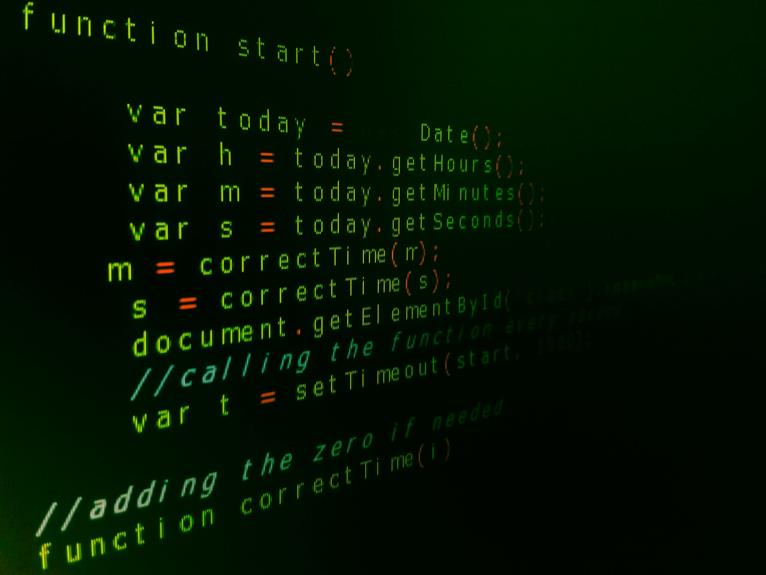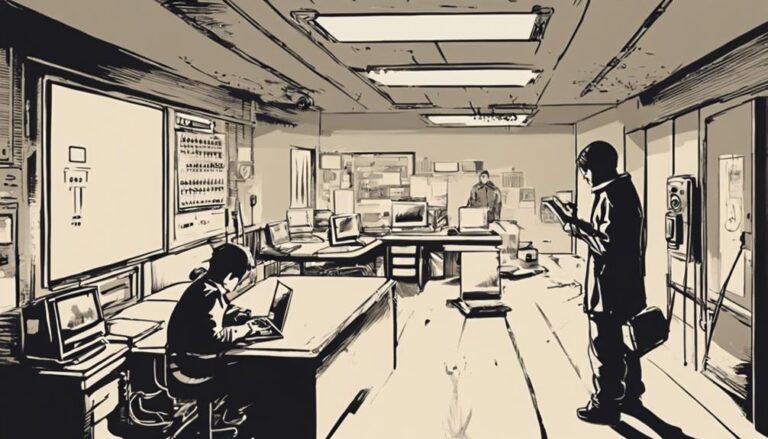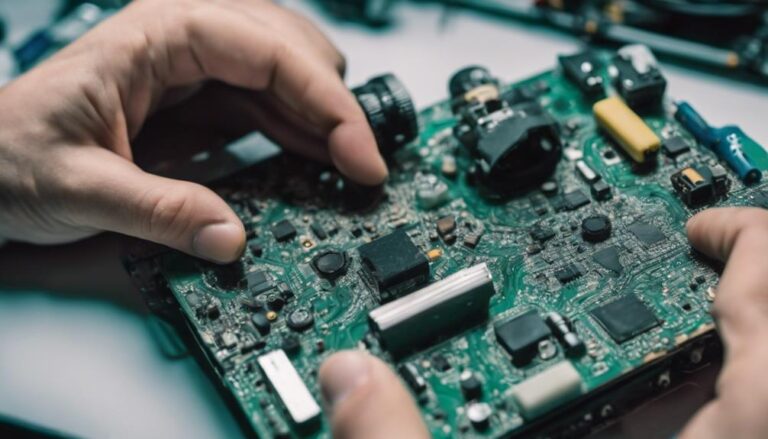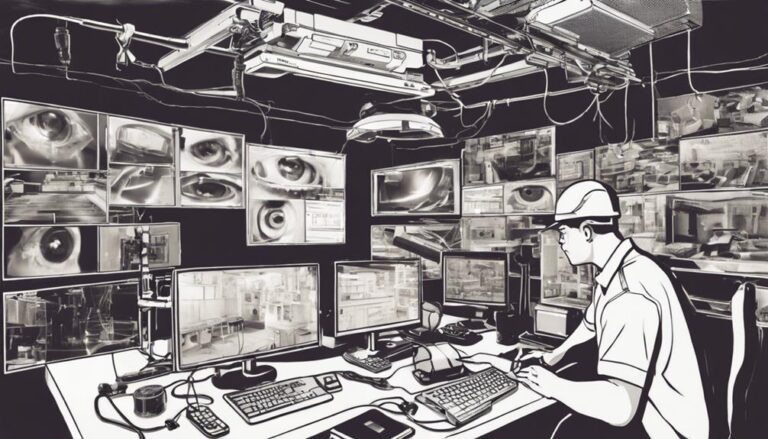To guarantee your security cameras function at their best, you need a fast and stable internet connection. Higher resolution cameras require more bandwidth, so opt for a high-speed plan and consider compression techniques to manage data usage. Each additional camera increases the data load, necessitating higher speeds to maintain smooth video streams. Prioritize upload speed for real-time monitoring and reduce latency by using wired Ethernet connections. Manage network traffic and consider cloud storage needs. For further tips on maximizing your network and camera settings, keep going.
Importance of Internet Speed
The speed of your internet connection is vital for guaranteeing that your security cameras function effectively. You don't want to miss any essential moments because of a slow or unreliable connection. With faster speeds, your cameras can stream high-quality video, allowing you to monitor your property in real-time without lag or interruptions.
Network reliability is another critical factor. A stable and dependable network ensures that your security cameras stay connected and functional at all times. Imagine the frustration of losing connection just when you need it most. To avoid this, you should invest in a robust and reliable network that can handle the demands of continuous video streaming.
Data caps can also be a significant concern. Many internet service providers impose limits on the amount of data you can use each month. If you exceed these limits, your internet speed might be throttled, or you could incur extra charges. Security cameras can consume a lot of data, especially if they're recording or streaming high-definition video. To maintain your freedom and avoid unexpected costs, choose an internet plan with high or unlimited data caps. This way, you can keep a watchful eye on your surroundings without any restrictions.
Factors Affecting Bandwidth
Understanding the factors affecting bandwidth can help you optimize your internet connection for seamless security camera performance. One key factor is network congestion. When too many devices are connected to your network simultaneously, the available bandwidth gets divided among them, causing slower speeds. To keep your security cameras running smoothly, consider managing the number of active devices or upgrading your internet plan to handle higher traffic.
Another significant aspect is device compatibility. Not all security cameras are created equal; some may require more bandwidth than others. Make sure your cameras are compatible with your network's capacity. Older devices or those with outdated firmware might not perform efficiently, leading to unnecessary bandwidth strain. Always check the specifications of your devices and update their firmware regularly to maintain peak performance.
Camera Resolution Impact
When selecting a security camera, you've got to think about how the camera's resolution impacts your internet speed. Higher resolution means clearer images but also requires more bandwidth, potentially straining your network. However, compression technology can help balance clarity and data usage, making it important to grasp its benefits.
Higher Resolution Bandwidth
Higher resolution cameras require significantly more bandwidth, impacting both your internet speed and data usage. When you choose higher resolution settings for your security cameras, you're opting for clearer, more detailed footage. However, this choice also means a significant increase in bandwidth usage. Imagine streaming a 4K movie versus a standard-definition one; your internet connection needs to be robust to handle that extra data.
You've got the freedom to decide what resolution works best for you, but it's important to understand the trade-offs. For instance, a 1080p camera will consume less bandwidth compared to a 4K camera, but it won't offer the same level of detail. If your internet plan has limited bandwidth, opting for higher resolutions might slow down your entire network, affecting other connected devices.
Think about your priorities. Are you willing to allocate more of your internet's capacity to ensure crystal-clear surveillance footage? Or do you need to balance it with your overall internet usage? Knowing the impact of resolution settings on bandwidth usage helps you make informed choices, ensuring your security system runs smoothly without bogging down your freedom to use the internet as you please.
Clarity Vs. Data Usage
Have you ever wondered how much data your security cameras are consuming based on their resolution? It's an important aspect to take into account, especially if you value both freedom and efficiency. High-resolution cameras provide excellent image clarity, which is vital for identifying details like faces or license plates. However, this clarity comes at a cost: increased data consumption.
When you opt for cameras with higher resolutions, such as 4K, you're looking at a significant spike in data usage. For instance, a 1080p camera might use around 1-2 Mbps, while a 4K camera can easily consume 8-12 Mbps or more. This means you'll need faster internet speeds and more bandwidth to support multiple high-resolution cameras without experiencing lag or interruptions.
But don't worry, you don't have to sacrifice your freedom for security. You can strike a balance by choosing the right resolution for different areas. For example, you might use high-resolution cameras in high-risk zones and lower-resolution ones in less critical areas. This way, you get the image clarity you need where it matters most, while managing your data consumption effectively. Balancing clarity and data usage ensures your security system operates smoothly without overburdening your internet connection.
Compression Technology Benefits
By utilizing advanced compression technology, you can greatly reduce the data usage of your high-resolution security cameras without sacrificing image quality. This means you'll enjoy the freedom of keeping your property secure without bogging down your internet connection or incurring hefty data costs. Compression algorithms like H.264 and H.265 play an essential role here. These algorithms efficiently shrink video files, making them easier to store and stream. You can maintain crisp, clear footage while ensuring your network doesn't get overwhelmed.
Encoding standards are another important component. They determine how video data is compressed and transmitted. Modern standards, such as H.265 (also known as HEVC), are designed to handle high-resolution video more effectively than older standards. This encoding standard can reduce file sizes by up to 50% compared to H.264, allowing you to stream and store more video without compromising on quality. When choosing security cameras, look for those that support these advanced compression algorithms and encoding standards.
Number of Cameras
When determining the internet speed needed for security cameras, the number of cameras you have greatly impacts the required bandwidth. Each camera adds to the total data load on your network, so it's important to take into account all devices. If you're covering multiple areas, strategic camera placement and considering viewing angles can optimize your setup without unnecessarily increasing the number of cameras. Place cameras where they can cover the widest angles possible, reducing blind spots and ensuring thorough coverage with fewer units.
More cameras mean more data being transmitted simultaneously, which demands higher internet speeds. For instance, a single high-definition camera might require 2-5 Mbps, but if you have five cameras, you could need up to 25 Mbps or more, depending on their resolution and frame rate. To maintain smooth, uninterrupted video streams, you'll need to make sure your network can handle this load.
Understanding this balance allows you to maintain security without compromising internet performance. Remember, your goal is to create a secure environment that doesn't tether you to a sluggish network. By carefully planning the number and placement of your cameras, you can enjoy both freedom and peace of mind.
Video Compression Techniques
When considering video compression techniques for your security cameras, you'll want to understand the different types of compression available. Balancing compression with video quality is essential, as higher compression can save bandwidth but might affect image clarity. Additionally, keep in mind how these choices impact your overall bandwidth requirements.
Types of Compression
Video compression techniques are essential for reducing the bandwidth and storage needs of security camera footage without sacrificing a considerable amount of quality. There are two primary types of compression you should know about: lossless compression and lossy compression.
Lossless compression retains all the original data, ensuring no loss in quality. It's great if you need crystal-clear footage for legal or identification purposes. However, it requires more bandwidth and storage. Lossy compression, on the other hand, reduces file sizes by discarding some data. While this results in a slight quality drop, it's usually imperceptible to the human eye and highly efficient for streaming and storage.
Here's a quick comparison to help you decide which suits your freedom-loving lifestyle:
| Feature | Lossless Compression | Lossy Compression |
|---|---|---|
| Quality | High, no data loss | Slight quality reduction |
| Storage Needs | High | Low |
| Bandwidth Needs | High | Low |
| Ideal Use | High-detail, forensic quality | General surveillance |
| Common Formats | PNG, FLAC | JPEG, MP3, H.264 |
Choosing the right compression technique can balance your need for quality and efficiency. Lossless is perfect for meticulous detail, while lossy offers freedom in managing storage and bandwidth.
Compression Vs. Quality
Finding a balance between compression and quality is essential to guarantee that your security cameras provide usable footage without overwhelming your network or storage. When video files are compressed too much, you'll encounter compression artifacts—those annoying pixelated or blurry sections that can obscure vital details. On the other hand, insufficient compression results in larger files, eating up bandwidth and storage space faster than you'd like.
You're looking for that sweet spot where the video quality remains high enough to identify faces, license plates, and other critical details, but the file sizes are manageable. High-efficiency video coding (HEVC) or H.265 is a common compression standard that offers better quality at lower bitrates compared to older standards like H.264. However, even with advanced compression techniques, pushing the limits can lead to quality degradation, making the footage less reliable for security purposes.
Bandwidth Considerations
Understanding bandwidth considerations is crucial when selecting video compression techniques for your security cameras. You want to guarantee your cameras provide clear footage without consuming excessive bandwidth. Balancing compression and quality is key, but don't overlook the importance of data encryption and security protocols.
Here's a quick breakdown to help you decide:
| Compression Technique | Bandwidth Usage | Quality |
|---|---|---|
| H.264 | Moderate | High |
| H.265 | Low | Very High |
| MJPEG | High | Excellent |
| VP9 | Low | High |
H.264 is a great middle-ground, offering good quality without hogging too much bandwidth. H.265, on the other hand, uses even less bandwidth while providing very high quality. MJPEG is known for excellent quality but requires significant bandwidth, not ideal if you're trying to optimize. VP9 offers a nice balance of low bandwidth use and high quality.
Upload Vs. Download Speed
When setting up security cameras, it's important to understand the difference between upload and download speeds to guarantee your system functions effectively. Many people focus on download speeds, driven by the need for fast streaming and browsing, but for security cameras, upload speed is essential. These cameras send data to the cloud or remote servers, requiring sufficient upload bandwidth.
Your internet connection might use asynchronous transfer, meaning your upload and download speeds are different. Typically, download speeds are higher, while upload speeds lag behind. For security cameras, this imbalance can be a bottleneck. If you have multiple cameras, all sending data simultaneously, you'll need a robust upload speed to avoid lag or dropped footage.
On the other hand, some internet plans offer symmetric speeds, where upload and download rates are equal. This is ideal for security systems, ensuring smooth, uninterrupted data transfer. Symmetric speeds can support multiple cameras more effectively, giving you the freedom to monitor your property without technical hiccups.
Understanding these aspects lets you choose the right internet plan to keep your security cameras running smoothly, ensuring your safety and peace of mind.
Real-Time Streaming Needs
When it comes to real-time streaming for security cameras, you'll need to take into account bandwidth requirements to guarantee smooth video feeds. The quality of the video directly impacts how much data is transmitted, affecting both clarity and speed. Latency is another critical factor, as delays can hinder your ability to respond promptly to any incidents.
Bandwidth Requirements
For a seamless real-time streaming experience for your security cameras, you'll need to take into account the bandwidth requirements based on the camera's resolution and frame rate. Higher resolution cameras, such as 4K, demand considerably more bandwidth compared to 1080p or 720p options. If your goal is to avoid any stuttering or lag, consider the combined effect of all your cameras running simultaneously, especially during peak usage times. This ensures your network can handle the load without compromising performance.
Balancing this need for bandwidth is essential, especially if you're restricted by data caps. Surveillance systems can consume a lot of data, and exceeding these caps could result in additional charges or throttled speeds. Think about how often you'll review footage and whether live streaming is necessary 24/7. Sometimes, setting cameras to record only when motion is detected can save a substantial amount of data.
Ultimately, if you crave the freedom to monitor your property without hassle, making sure your internet plan supports the necessary bandwidth for your security setup is vital. By understanding your specific needs, you can make informed decisions about your internet service provider and plan, giving you peace of mind and uninterrupted surveillance.
Video Quality Impact
To guarantee your security cameras provide clear and reliable real-time streaming, consider the direct impact of video quality on your internet speed requirements. Higher video quality ensures you won't miss important details, but it demands more from your internet connection. For instance, streaming in 4K requires a substantial amount of bandwidth compared to 720p. You've got to balance the need for high-definition footage with the available bandwidth to avoid buffering or lag.
Lighting conditions also play a vital role. Poor lighting can degrade video quality, necessitating higher resolution and frame rates to capture clear images, which again increases your bandwidth needs. So, make sure your cameras are placed in well-lit areas to optimize performance without taxing your internet speed excessively.
Additionally, think about your storage capacity. Higher quality video consumes more storage, meaning you'll need ample space to keep your footage. If your internet connection can't handle the higher bandwidth, you might need to compromise on video quality or invest in better storage solutions. By carefully evaluating these aspects, you can maintain the freedom to monitor your property efficiently without overloading your internet connection.
Latency Considerations
Balancing video quality with internet speed is essential, but don't overlook the importance of low latency for smooth, real-time streaming. Network latency affects how quickly data travels from your security camera to your viewing device. High latency can create delays, making it difficult to respond swiftly to any incidents.
When setting up your security cameras, consider the impact of signal interference. Wi-Fi signals can be disrupted by walls, electronic devices, and even other Wi-Fi networks, which can increase latency. Opting for a wired connection can minimize these disruptions and provide a more reliable stream.
Here's a quick comparison to help understand the balance between speed and latency:
| Connection Type | Latency (ms) | Speed (Mbps) | Signal Interference |
|---|---|---|---|
| Wired Ethernet | 1-5 | 100-1000+ | Low |
| Wi-Fi (5 GHz) | 5-20 | 150-867 | Medium |
| Wi-Fi (2.4 GHz) | 20-50 | 54-600 | High |
| Cellular | 50-100+ | 5-50 | Variable |
Choosing the right setup allows you to enjoy the freedom of monitoring your property in real-time without frustrating delays. Prioritize reducing network latency and avoiding signal interference to get the most out of your security system.
Cloud Storage Considerations
When considering cloud storage for your security cameras, it's important to understand how your internet speed impacts video upload and access times. If your upload speed isn't fast enough, you may experience delays in storing footage, which can be critical for real-time monitoring. To guarantee smooth operation, you'll need to account for both storage redundancy and data retention.
Storage redundancy is important for safeguarding your footage. Cloud services typically offer multiple copies of your data across different servers, but this comes at the cost of increased bandwidth usage. Faster upload speeds will help you take full advantage of these features without slowing down your network.
Data retention policies also play a role in how much speed you need. Longer retention periods require more storage space and, consequently, more bandwidth to upload and manage the data.
Here are some key considerations:
- Upload speed requirements: Make sure your internet plan supports the necessary upload speeds.
- Storage redundancy: Multiple backups need higher speeds to avoid delays.
- Data retention policies: Longer periods necessitate more bandwidth.
- Scalability: Consider future needs and whether your current speed can handle additional cameras or higher resolution footage.
Balancing these factors will help you maintain an efficient and reliable security system.
Network Traffic Management
Managing network traffic is crucial to guaranteeing your security cameras run smoothly without compromising other internet-dependent devices. You want the freedom to stream movies, browse the web, and have video calls without interruption, right? That's where traffic shaping and QoS settings come into play.
Traffic shaping allows you to prioritize certain types of data over others. By giving your security cameras a higher priority, you guarantee that their video feeds remain seamless, even when your network is busy. Imagine being able to watch a high-definition video on your security camera while someone else in your household streams a 4K movie without either one lagging—that's the power of traffic shaping.
QoS (Quality of Service) settings take this a step further. QoS can be configured to allocate specific bandwidth amounts to different devices or applications. This way, your security cameras get the bandwidth they need, and you maintain smooth performance across all your gadgets. You're in control, ensuring that your network works for you, not against you. So, by mastering these tools, you can keep your home secure and your internet experience uninterrupted.
Tips for Optimizing Speed
To optimize your internet speed for security cameras, start by placing your router in a central location to guarantee even coverage throughout your home. This simple step can drastically improve signal strength and reduce dead zones.
Here are some additional tips to make sure you're getting the most out of your internet connection:
- Minimize signal interference: Keep your router away from other electronic devices like microwaves, cordless phones, and even baby monitors, as these can disrupt the signal.
- Upgrade your router: If you're using an older model, consider upgrading to a more modern router that supports the latest Wi-Fi standards, such as Wi-Fi 6, for better performance and range.
- Use wired connections: For critical security cameras, using an Ethernet cable can provide a more stable connection than Wi-Fi, eliminating issues with signal interference.
- Optimize camera settings: Adjust your security cameras to lower resolution settings if high-definition isn't necessary for all areas. This can reduce the bandwidth needed and improve overall performance.
Frequently Asked Questions
Can Security Cameras Work With Mobile Hotspots?
Yes, you can utilize mobile hotspots for security cameras, but be mindful of power consumption and signal interference. You'll appreciate the flexibility, but make sure your mobile data plan and hotspot can manage continuous usage effectively.
How Does Internet Speed Affect Night Vision Cameras?
Low bandwidth can seriously affect your night vision cameras, causing latency issues. You don't want delays when monitoring your property, especially at night. Ensure you have sufficient internet speed to keep everything running smoothly and securely.
Do Wired Cameras Need the Same Internet Speed as Wireless Ones?
Wired cameras are like lightning compared to wireless ones! They don't need the same blazing internet speed because they handle data storage and network latency more efficiently, giving you the freedom to roam without buffering worries.
Can I Use Satellite Internet for My Security Cameras?
You can use satellite internet for your security cameras, but consider weather conditions and data caps. Satellite internet's reliability dips in bad weather, and data caps might limit your camera's functionality. Seek alternatives for better freedom.
How Does Internet Speed Impact Motion Detection Alerts?
Imagine you're the town crier: internet speed's vital for motion detection alerts. Latency issues can delay notifications, while bandwidth requirements guarantee smooth video feeds. Faster speeds mean real-time alerts, giving you peace of mind and freedom.



